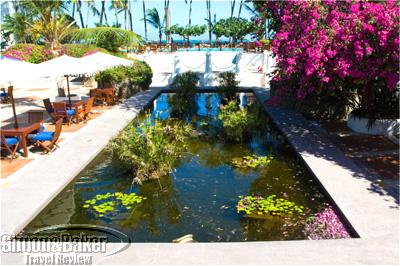Article and photos by Josette King

The beach at the Serena Beach Hotel and Spa in Mombasa
While I enjoy the comfort and amenities of luxury hotels, I often find them in some way at odds with my commitment to responsible tourism, which requires that “facilities invest time, money and other resources in betterment of the environment, resource use and the welfare of local communities” (per the 2002 Cape Town Declaration on Responsible Tourism). I had no such concerns on my recent visit to Kenya, where I stayed at two outstanding Serena Hotels, whose luxury accommodations met responsible tourism practices.
These properties, owned by Tourism Promotion Services Eastern Africa, Ltd (TPS, with the Aga Khan Fund for Economic Development (AKFED) the majority shareholder, had a stated policy of commitment to the local population in relation to cultural preservation, sustainable habitat and community development. The group also operated by a code of responsible practices regarding energy conservation, waste recycling, sewage disposal, air emissions, pesticides, noise reduction and visual pollution, and construction of their properties in harmony with local surroundings, using eco-friendly materials, and local handicrafts and products.

The Sokoni Pond at the Serena Beach Hotel and Spa
These principles were very much in evidence at the Serena Beach Hotel and Spa in Mombasa. Inspired by the rich architectural tradition of the East African coast, the resort was built of local material by local craftsmen into whitewashed low buildings with intricately carved deep wooden balconies overlooking courtyards shaded by blooming bougainvilleas and frangipani trees. The buildings were clustered around a central core of elegant public spaces that gave the resort the exotic appeal of an ancient Swahili town. The Village area, where my room was located, was styled to resemble the historic island town of Lamu, with its back streets winding toward the sea. My room combined the charm of local carved Lamu-style furniture, arts and crafts with the latest modern conveniences.
The atmosphere of the common areas was that of an Arabian palace, with soaring pillars, tiled fountains and Arabic furnishings and rugs. I especially liked the abundance of elegant fretwork panels throughout the property, including the Maisha Spa, said to have been made by members of the Association for the Physically Disabled of Kenya. The spa also provided an outlet for goods created by the disabled. The leather tongs used by spa guests were sourced from a local community organization that supported the disabled. These and a number of jewelry items created by the same group could be purchased at the spa reception.

The Sokoni Nyota at the Serena Mombasa Beach Hotel
A majority of the hotel staff and visiting entertainers were drawn from the local community. Providing growth opportunities for the staff was a matter of pride within the Serena organization. I spoke to several members of the senior management team, including Charles Muia, general manager, who mentioned how some staff members had started in junior positions at Serena properties and had benefited from the company’s development program to ascend to their current positions. Muia also pointed out junior staff members presently enjoying similar opportunities at the hotel and the spa. Much of the fresh foodstuffs served in the restaurants were locally produced and procured, including the seafood that was bought from accredited local suppliers.
The Serena was graced with a seemingly endless frontage of verdant lawns and soaring palm trees overlooking a pristine creamy sand beach that was part of the Mombasa Marine National Park and Reserve, established to protect the marine and coastal environment of the Indian Ocean territorial waters. The hotel cooperated with the Kenya Sea Turtle Conservation Committee on a rescue and conservation project aimed to protect the nesting and feeding sites of seven species of migratory turtles. It also provided a secure nesting ground to protect the hatching cycle of the baby turtles.

Nairobi Serena Hotel facade
While some of the least visible responsible tourism practices are hard to observe within the infrastructure of a large city hotel, the Nairobi Serena Hotel, the Serena flagship hotel in Kenya, was said to uphold the same high standards as the resort property. The six-story structure sat discretely among its own lush tropical gardens at the edge of the city’s Central Park to offer an oasis of serenity in the heart of Africa’s fourth largest city. I especially enjoyed its décor that seamlessly blended Moroccan and Swahili influences with tribal antiques and contemporary African art to create an environment of refined elegance.

Nairobi Serena Hotel sign
Several restaurants featured a variety of cuisine options, mainly from locally sourced products. Throughout the hotel the staff was efficient and polished. My room was cool and quiet, elegantly decorated in pan-African style, overlooking gardens filled with native flowering trees, and the glittering towers of the downtown Nairobi skyline beyond. Thanks to its efficient WiFi connection and satellite television with multiple international channels, it was an inviting haven to reconnect with the “modern world” after an extended safari before facing the long journey home.
Details on my visit to Kenya, and dedicated articles on the Serena Beach Hotel and Spa, Maisha Spa and the Nairobi Serena Hotel can be found on our main website at Simon and Baker Travel Review.









I am really impressed by the initiative aken by Serena in the Promotion of Responsible Tourism. I hope they can do the same at Serena Uganda. They have even acquired another property formerly Ranch on The Lake 15km on Kampala-Entebbe road. They should also not forgett the disabled access areas that we are yet to catch on in Uganda
Now this is welcome news. I love hearing things like this. Luxury travel and tourism as a whole is a business which is heavily dependent on a destination’s natural beauty so I think it is just right that hotels and tourism organizations spearhead the effort to promote “green” practices.